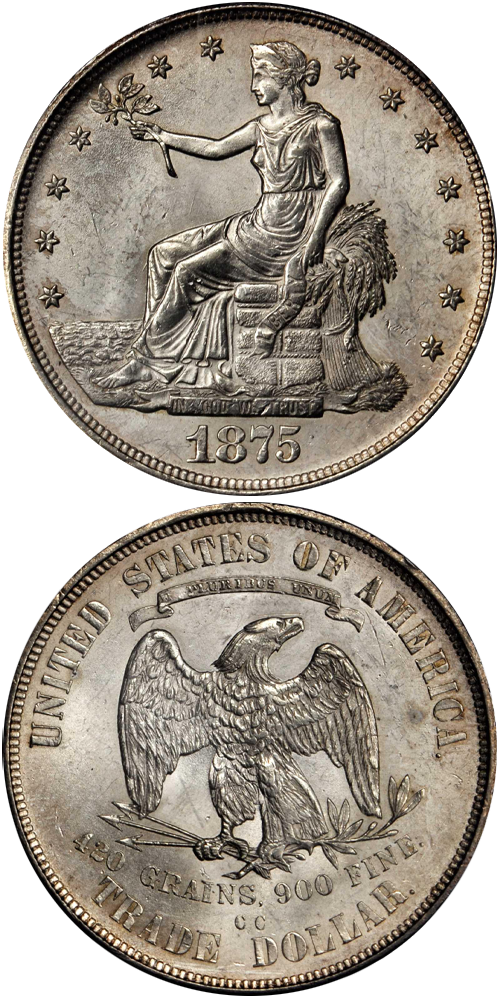1875-CC Trade Dollar
Jeff Ambio: Type I obverse and reverse with the ribbon ends on the obverse pointing left and a berry on the olive branch directly below the eagle's right (facing) talon on the reverse. The tall CC mintmark is 1.2 mm in height.
Rusty Goe: Superintendent James Crawford and Coiner William "Hy" Doane told reporters in January 1875 that the Carson Mint's building and equipment were inadequate to handle the volume of work assigned to it. Crawford appealed to Nevada's legislature to memorialize Congress for appropriations to enlarge some departments, buy more machinery, and hire additional employees. He described how coinage production had increased nearly fivefold from 1872's output to the level achieved in 1874. As Comstock yields increased in 1875 and could double by 1876, Crawford showed how the Carson Mint would need larger capacity to handle the corresponding workload.The Carson coiners had averaged 216,500 trade dollars a month in the last quarter of 1874. In January 1875, it turned out 225,000 of the large silver coins.
Trade dollar production slumped between February and April, as the monthly average dropped to 54,000, while the Carson Mint concentrated on the heavy orders it received for smaller subsidiary silver coins. In May, the coining department delivered 278,000 trade dollars, the highest monthly total in the mint's history. A lull of sorts in the coining of trade dollars occurred in the ensuing three months, as the mint averaged about 41,250 in each through August. This happened in part because of the shutdown during most of June for annual cleanup and settlement. Additionally, a huge $1.5 million bullion deposit made by the Consolidated Virginia Mine in June shifted mint workers' energies from coining to assaying and refining during the summer months. Director of the Mint H.R. Linderman sent a dispatch to Pacific Coast newspapers in July 1875, to notify readers of his plans to prepare the Western mints to turn out at least $4 million in subsidiary silver coins in the last six months of the year. The Daily Alta of July 27, 1875, reported that the two new coin presses and other machinery Superintendent Crawford had ordered had "been placed in position and will more than double the coinage capacity of the Carson Mint.
With the addition of new employees, came the replacement of Coiner Doane. Levi Dague, selected by Crawford, received his commission and assumed his position as head of the coining department in August 1875.Trade dollar production launched into accelerated mode starting in September and continuing through November, averaging about 250,000 a month. In December, Dague delivered the final 61,000 pieces, which brought the output for 1875 to 1,573,700, the peak level ever achieved at the Carson Mint.
Q. David Bowers: Rusty Goe estimates that 1,800 to 3,000 1875-CC trade dollars exist in all grades and 350 to 400 Uncirculated. The 1875-CC was produced in larger numbers than any other trade dollar from this mint. Most 1875-CC trade dollars were exported, although it is likely that by this time some circulated in domestic service, particular in commercial channels on the West Coast.
The example to the left was sold by Stack's Bowers Galleries in the Blue Moon Collection Part I, where it realized $8,812.






